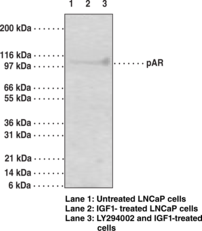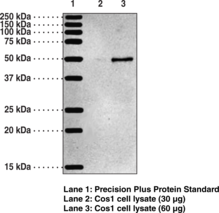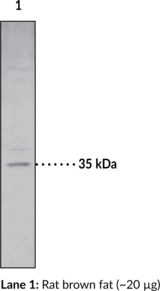Description
The androgen receptor (AR) is an ~100 kDa androgen-dependent transcription factor that is a member of the steroid/nuclear receptor gene superfamily. The AR signaling pathway plays a key role in development and function of male reproductive organs, including the prostate and epididymis. AR also plays a role in nonreproductive organs, such as muscle, hair follicles, and brain. Abnormalities in the AR signaling pathway have been linked to a number of diseases, including prostate cancer, Kennedy’s disease, and male infertility. The phosphatidylinositol 3-kinase (PI3K)/Akt signaling pathway plays an important role in regulating AR activity through phosphorylation of AR at Ser213/210 and Ser791/790. Growth factors or cytokines may induce phosphorylation of AR through the PI3K/Akt pathway. IGF-1 activates the PI3K/AKT pathway in LNCap at high passage number and increases phosphorylation of the AR at Ser213/210 and Ser791/790.{17381} The western blot results also show that inhibition of the PI3K/Akt pathway by LY294002 prior to incubation with IGF-1 suppressed AR phosphorylation at Ser213/210. Activation of the PI3K/Akt pathway is thought to have a survival role in prostate cancer by protecting cells from apoptosis.
Synonyms: AR
Immunogen: synthetic peptide from human androgen receptor amino acids 207-221
Formulation: 0.1 mg of protein G-purified IgG in 0.2 ml PBS containing 0.05% BSA and 0.05% sodium azide
Isotype:
Applications: WB and IHC (paraffin-embedded)
Origin: Animal/Mouse
Stability: 365 days
Application|Immunocytochemistry||Application|Western Blot||Product Type|Antibodies|Monoclonal Antibodies||Research Area|Cancer|Cell Signaling|PI3K/Akt/mTOR Signaling




